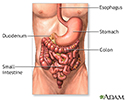Stools – floating
Floating stoolsStools that float are most often due to poor absorption of nutrients (malabsorption) or too much gas (flatulence).
Malabsorption
Malabsorption involves problems with the body's ability to take in (absorb) nutrients from food.

Gas
Gas is air in the intestine that is passed through the rectum. Air that moves from the digestive tract through the mouth is called belching. Gas is ...

Considerations
Most causes of floating stools are harmless. In most cases, floating stools will go away without treatment.
Floating stools alone are not a sign of an illness or other health problem.
Causes
Many things can cause floating stools. Most of the time, floating stools are due to what you eat. A change in your diet may cause an increase in gas. Increased gas in the stool allows it to float.
Floating stools may also happen if you have a gastrointestinal infection.
Floating, greasy stools that are foul smelling may be due to severe malabsorption, particularly if you are losing weight. Malabsorption means your body is not properly absorbing nutrients.
Most floating stools are not caused by an increase in the fat content of the stool. However, in some conditions, such as long-term (chronic) pancreatitis, the fat content is increased.
Home Care
If a change in diet has caused floating stools or other health problems, try to find which food is to blame. Avoiding this food may be helpful.
When to Contact a Medical Professional
Tell your health care provider if you have changes in your stools or bowel movements. Contact your provider right away if you have bloody stools with weight loss, dizziness, and fever.
What to Expect at Your Office Visit
Your provider will perform a physical exam and ask questions about your medical history and symptoms, such as:
- When did you first notice the floating stools?
- Does it happen all the time or from time to time?
- What is your usual diet?
- Does a change in your diet change your stools?
- Do you have other symptoms?
- Are the stools foul smelling?
- Are the stools an abnormal color (such as pale or clay-colored stools)?
Pale or clay-colored stools
Stools that are pale, clay, or putty-colored may be due to problems in the biliary system. The biliary system is the drainage system of the gallblad...
 ImageRead Article Now Book Mark Article
ImageRead Article Now Book Mark Article
A stool sample may be needed. Blood tests may be done. In most cases, however, these tests will not be needed.
Treatment depends on the specific diagnosis.
References
Höegenauer C, Hammer HF. Maldigestion and malabsorption. In: Feldman M, Friedman LS, Brandt LJ, eds. Sleisenger and Fordtran's Gastrointestinal and Liver Disease. 11th ed. Philadelphia, PA: Elsevier; 2021:chap 104.
Schiller LR, Sellin JH. Diarrhea. In: Feldman M, Friedman LS, Brandt LJ, eds. Sleisenger and Fordtran's Gastrointestinal and Liver Disease. 11th ed. Philadelphia, PA: Elsevier; 2021:chap 16.
Semrad CE. Approach to the patient with diarrhea and malabsorption. In: Goldman L, Cooney KA, eds. Goldman-Cecil Medicine. 27th ed. Philadelphia, PA: Elsevier; 2024:chap 126.
-
Lower digestive anatomy - illustration
Food passes from the stomach into the small intestine. In the small intestine all nutrient absorption occurs. Whatever has not been absorbed by the small intestine passes into the colon. In the colon most of the water is absorbed from the food residue. The residue is then eliminated from the body as feces.
Lower digestive anatomy
illustration
-
Lower digestive anatomy - illustration
Food passes from the stomach into the small intestine. In the small intestine all nutrient absorption occurs. Whatever has not been absorbed by the small intestine passes into the colon. In the colon most of the water is absorbed from the food residue. The residue is then eliminated from the body as feces.
Lower digestive anatomy
illustration
Review Date: 6/11/2024
Reviewed By: Jenifer K. Lehrer, MD, Department of Gastroenterology, Aria - Jefferson Health Torresdale, Jefferson Digestive Diseases Network, Philadelphia, PA. Review provided by VeriMed Healthcare Network. Also reviewed by David C. Dugdale, MD, Medical Director, Brenda Conaway, Editorial Director, and the A.D.A.M. Editorial team.


